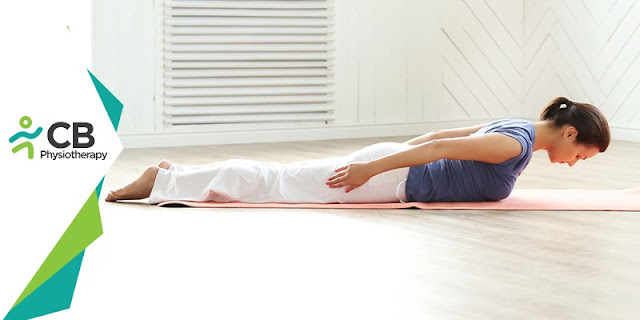Top 10 Stretching and Strengthening Exercises for Lower Back
Exercises and Physical activity is what makes our body healthy and fit. Inactivity and Immobility is what weakens our abdominal and back muscles thus making them more prone to strain. Stiff muscles put a strain on the vertebrae hence limiting the spine's natural movements. But physiotherapy exercises can help you alleviate tension, reduce pain, and support the spine. Below mentioned are 10 lower back Exercises that can be recommended by a well-trained physiotherapist.
Muscles in the low back, buttocks, abdomen, and hips are necessary for stabilizing and supporting the spine. Keeping these muscles active and strong can help minimize back pain and avoid low back injury. Specific exercises should be prescribed based on the individual's needs. These exercises consist of stretching and strengthening, and also include regular aerobic conditioning.
Abdominal Tucks:
This exercise helps with flexibility, improves blood flow, and enhances movement. The abdominal tucks increase the core body temperature. It warms up the muscles across the abdomen, transverse abdominal muscle as well as the supporting tissue of the core.
- The patient lies on the back with both the knees bent and feet flat.
- Place one hand tightly on the abdomen and tighten the abdominal muscles.
- Then pull towards the spine without holding your breath.
- Perform two sets of 10 repetitions.
Core muscles:
The core muscles are the muscles of the abdomen, back, and pelvis. Exercises that stabilize the core are trained first to reduce low back pain. Core marching works these muscles in a pain-free way.
- The patient lies on the back with knees drawn up and feet flat, engaging the abdominal muscles.
- Maintain this pattern, lift one knee toward the chest without using the hands.
- Keep the abdominals engaged until the patient puts the foot back in the starting position.
- Repeat 15 to 20 times.
Lumbar Extensors:
The posture helps to ease pain and improves overall flexibility. The child pose stretches the low back muscles, as well as the lumbar extensors. This simple stretching exercise is ideal for opening up the lower back and alleviating pain.
- Kneel on the floor and sit on the heels.
- Bend forward with the arms extended in front until the forehead rests on the floor.
- Hold this position for 30 seconds, or as long as the relief is felt from the stretch.
Hip Adductors
- The patient attains a standing position, placing the inside of the ankle on a table or bed.
- Bring the opposite arm straight up next to the ear.
- Lean into the stretching leg and hold this position for 20 to 30 seconds.
- Repeat on each side 3 times.
Hamstrings
- Stand by facing the bed or table.
- Place the back of the heel on the surface so that the leg is straight.
- Lean forward at the hips to stretch the hamstring.
- Hold for 30 seconds and relax.
- Repeat 3 times on each side.
Bird dog hip Extension:
This exercise helps to stabilize the lower back and also the abdominals.
- The patient begins on the hands and knees, shoulders over hands and hips over knees
- Slowly stretch one arm and the opposite leg straight out e.g. right arm, left leg, or vice versa.
- Hold this position for 10 to 15 seconds and bring the limbs slowly down.
- Repeat 15 to 20 times, each time.
Bridging
- The patient begins by lying on a mat on the floor with knees up and feet flat in a comfortable space away from the hips.
- Keep the arms on the floor, and lift the hips off the ground to make a bridge Maintain a straight line from the chest to the knees.
- Hold for 5 to 10 seconds, keep the shoulder blades and neck on the ground, glutes, and abdominals engaged the whole time.
- Slowly bring down the hips to the floor.
- Repeat 15 to 20 times.
Side-to-Side
- The patient lies on the back with the feet pulled toward the hips and the knees up.
- Twist the knees gently to one side and stop when the patient feels that the hips start to come off the table or mat. Keep the upper body in position.
- Bring the knees back the other way and do the same thing on the other side.
- Repeat 25 to 30 times.
Press-ups:
- The patient lies flat on the stomach, brings the elbows to the sides, and places the hands just above the shoulders. The legs should be fully extended, hips with the mat or floor.
- Pull the shoulder blades back and lift the chest off the ground.
- Hold for 5 seconds, making sure that the legs and hips stay in contact with the floor or mat. The neck should stay long and in line with the upper spine the entire time.
- Slowly return the chest to the ground.
- Repeat 15 to 20 times.
Prone Cobras
- The patient lies flat on the stomach with the legs extended, arms at the sides, and hands pressed to the legs.
- Then lifts the chest off the ground, without using the hands, keeping the neck in line. Pull the shoulder blades in and flex the glutes throughout.
- Hold this position for 3 to 5 seconds before slowly lowering the upper body back to the mat or floor.
- Repeat 10 to 15 times.
Back pain usually goes away without surgery or too much effort. Sometimes there's nothing you can do to avoid back pain, but physiotherapy treatment is one of the best ways to live a life free of back pain.
This Article was first Published at CB Physiotherapy

